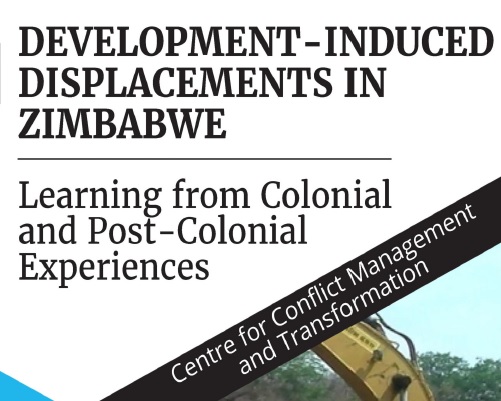
Large-scale development projects providing critical infrastructure and enhancing natural resource exploitation for economic growth have all too often been associated with the negative social impact of internal displacements of rural communities.
Zimbabwe’s history of planned displacements is part and parcel of the colonization process. Colonial efforts to develop infrastructure, agriculture and mining within a racially segregated society were anchored in the displacement of the indigenous African people into native reserves. Their social and economic livelihoods were deliberately disrupted in order to serve as a source of cheap labour for the colonial settlers. The long-lasting negative effects of these developments on the local communities are still deeply felt in many areas of Zimbabwe.
The book titled: Development-Induced Displacements in Zimbabwe – Learning from Colonial and Post-Colonial Experiences and published by Centre for Conflict Management and Transformation (CCMT), explores the history and scope of the problem in Zimbabwe.
It provides detailed case studies and makes recommendations on what could be done to balance the interests of government in bringing development and those of the rural communities who are required to cede all or part of their land to pave way for development.
In her foreword in the book, Ambassador Mary Mubi said the country’s development agenda prioritizes inclusive growth, with the devolution process providing a mechanism for provinces to plan and prioritize development projects that take advantage of the comparative and competitive advantage of each province while ensuring that the people remain at the centre of development.
“In Zimbabwe, the devolution process provides an opportunity to improve such development projects and mitigate negative impact by incorporating elements of a bottom-up approach. The different ways in which such projects are planned, and the mechanisms put in place for consultation with local communities, are crucial in minimizing the degree to which communities may be negatively affected,” Ambassador Mubi said.
“The book provides a timely opportunity for stakeholders, including government ministries, local authorities, development partners, researchers, and civil society, to have a conversation about the social and economic impact of development-induced displacements in Zimbabwe and to reflect on the past and present experiences and practices. In order to learn from our past, we need to document past experiences and analyse them. The detailed case studies in this book provide crucial evidence that will inform future practices,” she added.
CCMT has been conducting local interventions to transform land and displacement conflicts between local authorities and communities in the Midlands Province with the goal of facilitating mutually acceptable win-win solutions. The interventions have since transformed into evidence-based advocacy process aimed at influencing policy and legislative change on Development Induced Displacements (DID).
In this regard, CCMT held a series of multi-stakeholder policy dialogues with a view to generate discussions and build consensus around the key issues.
Key issues highlighted in the book include:
- i. Free, prior, and informed consent (FPIC) – Concept emphasizes meaningful participation as opposed to mere involvement.
- ▪ The current situation is that there is often no meaningful participation of communities in the planning and implementation of development projects and the terms of relocation or compensation. Development projects come as a surprise for most communities resulting in the rejection of the projects and conflict with the people bringing the development project. In instances where they are consulted, it is usually just a formality.
▪ Relocation and compensation of communities to pave way for development projects should be covered by the principle of Free (absence of intimidation and manipulation) prior (consent is sought in advance of the development project) and informed consent (providing the affected communities with all the necessary information, it also means more than just consultation and implies agreement and active participation).
- ii. Fair and comprehensive compensation
- ▪ The current situation is that communities are not receiving adequate and fair compensation, and that potential negative effects of projects for local communities are not adequately mitigated e.g., small-scale farmers on communal land and beneficiaries of the land reform are vulnerable to displacement without adequate. Also, SI 53/2014 on A1 settlement permits prescribes compensation for improvements and standing crops, but no replacement or compensation for the land itself.
- ▪ The problem is further compounded by the fact that, in many cases various authorities at different levels seem to employ an ad-hoc approach and procedures. There seems to be no harmonized approach clear minimum requirements across all categories of land in terms of how to deal with development-induced displacements and compensation and resettlement procedures and requirements. These issues have resulted in tensions between the affected communities and the those bringing the development project.
- ▪ Compensation should be guided by the principle of equivalence: affected people should be neither enriched nor impoverished due the process.
- – Financial payments, replacement of structures and assets or any other form of support.
- – Compensation is guided by the principle of equivalence. Affected people should not be enriched or impoverished due to the process.
- – Immovable assets should be determined and negotiated by an independent and transparent valuation process.
- iii. Inclusive socio-economic development and profit-sharing schemes
- ▪ There is tendency by some private and public institutions to only consider physical displacements when compensating affected communities. There is need consider both physical and economic displacements that may be caused by the implementation of development projects.
- – Provision of alternative sources of livelihoods and access to social support programs if equivalent land for agricultural production is not available.
- – Commission Environmental, and Social Impact Assessments (ESIAs) that inform resettlement and compensation plans, where the project does not satisfy EISA requirements, the project should be suspended.
- iv. Relocation and compensation of affected communities before the commencement of the project.
- ▪ Currently the focus by some private and public institutions in the implementation of development projects is on and or there is bias on economic development (GDP, financial & technical viability) as opposed to human development (expansion of people’s capacities & capabilities).
- ▪ To avoid loss of resources, infrastructure and facilities and services, there is need to cater for the environmental and social impact of development projects on receiving communities when planning and implementing the projects through budgeting for the relocation and compensation of affected communities prior to the commencement of the development projects. in many cases relocation and compensation processes are often severely delayed due to it being an after-thought in the project planning and budgeting.
- ▪ Compensation should not be once off; development projects should provide direct
